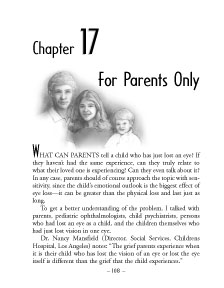 |
| The parents of a child who has lost vision in one eye can be crucial determinants of their child's reaction and subsequent adjustment to monocular vision. Here, Mr. Brady offers an excellent advice summary of the advice of experts. "There seems to be general agreement on several points: Discussions of the loss must be adjusted according to the child's age, sex, emotional stability, maturity, natural coordination, athletic inclination, and the child-parent relationship. Moreover, if the parents recognize the true impact of eye loss, this will help them maintain a calm, dispassionate attitude that can prevent the build-up of exaggerated fears. Certainly, emotional displays in the presence of the child are out of order. They all agree that children, in general, adapt quickly, and that the younger the child, the quicker and more complete is the adaptation." (pg. 119) Chapter 1. An Unhappy Landing Chapter 2. An Awkward Takeoff Chapter 3. Jolts of Reality Chapter 4. Flying High Chapter 5. How About You? Chapter 6. Seeing in 3-D—How It Works Chapter 7. What Has Changed? Chapter 8. Getting Back to 3-D Chapter 9. Avoiding Problems and Possible Mistakes Chapter 10. In the Driver’s Seat Chapter 11. The Active Life Chapter 12. Let Technology Help Chapter 13. Keeping the Good Eye Good Chapter 14. Seeing to Your Looks Chapter 15. Eye-making (Ocularistry) Chapter 16. Driving and Piloting Licenses Chapter 17. For Parents Only Chapter 18. Senior Class Chapter 19. In Good Company Glossary Resources |